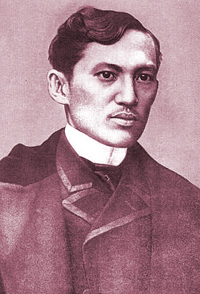
1 PISO COIN - PHILIPPINES - JOSE RIZAL
(KM 209)
Date: A.D. 1976
Obverse: Portrait facing - REPUBLIKA NG PILIPINAS 1 PISO JOSE RIZAL
Reverse: Shield - ANG BAGONG LIPUNAN (The new society) 1976 BANGKO SENTRAL NG PHILIPINAS (Central Bank of Philippines)
Engraver: James Ferrell
|
This coin was minted in the Philippines, a small group of islands in Southeast Asia. The island was held by Spain for centuries until the Spanish American war transferred the nation to America who introduced democracy and held it as a commonwealth for roughly 50 years until Independence was granted on July 4, 1946 . The official language of the Philippines is English although there are almost 200 other native dialects as well as Spanish and Arabic. Centuries of Spanish rule, decades of American influence, Polynesian and Asian influence all blend to give this emerging nation a very eclectic and sometimes segmented society and culture. This coin depicts Jose Rizal, considered the Philippines greatest patriot and national hero. His most famous writings Noli Me Tangere and El Filibusterismo were social commentaries of life under Spanish colonial rule. These books angered both the Spaniards and the Hispanicized Filipinos and led to Rizal's trial and prosecution as the inciter of revolution and, eventually, to a military trial and execution. His death by firing squad at the age of 35 is considered not only a supreme sacrifice for the people of the Philippines but an act of martyrdom and persecution that would help fuel the Philippine Revolution. A Writer and reformer by nature who reported on colonial rule and spoke out for equal rights, fair laws, and freedom of speech he was less a revolutionary but a moderate reformer in a nation that saw even his La Liga Filipina, a civic action group advocating moderate reforms through legal means, as an act of rebellion and sedition. Rizal was not a fighter but a man of letters instructed in various academies in the Philippines and Europe where he studied Spanish, French, Latin and German. In his short life he was a writer and a poet, an amateur architect, artist, educator, novelist, sculptor, philosopher and most of all a spokesman for civil rights. For his great contributions and sacrifice he is considered the father of the country and its greatest hero. |

